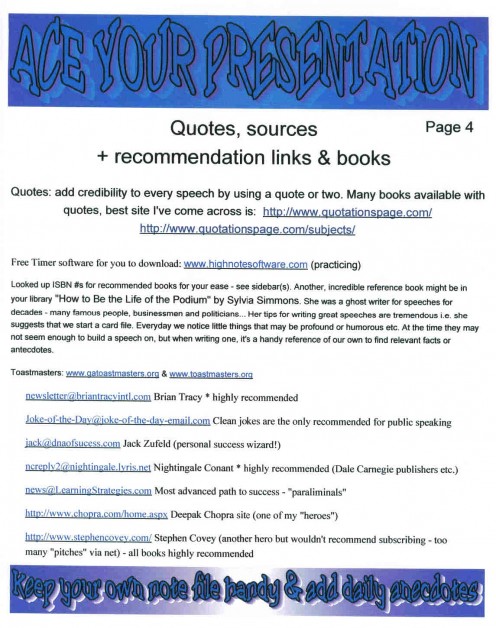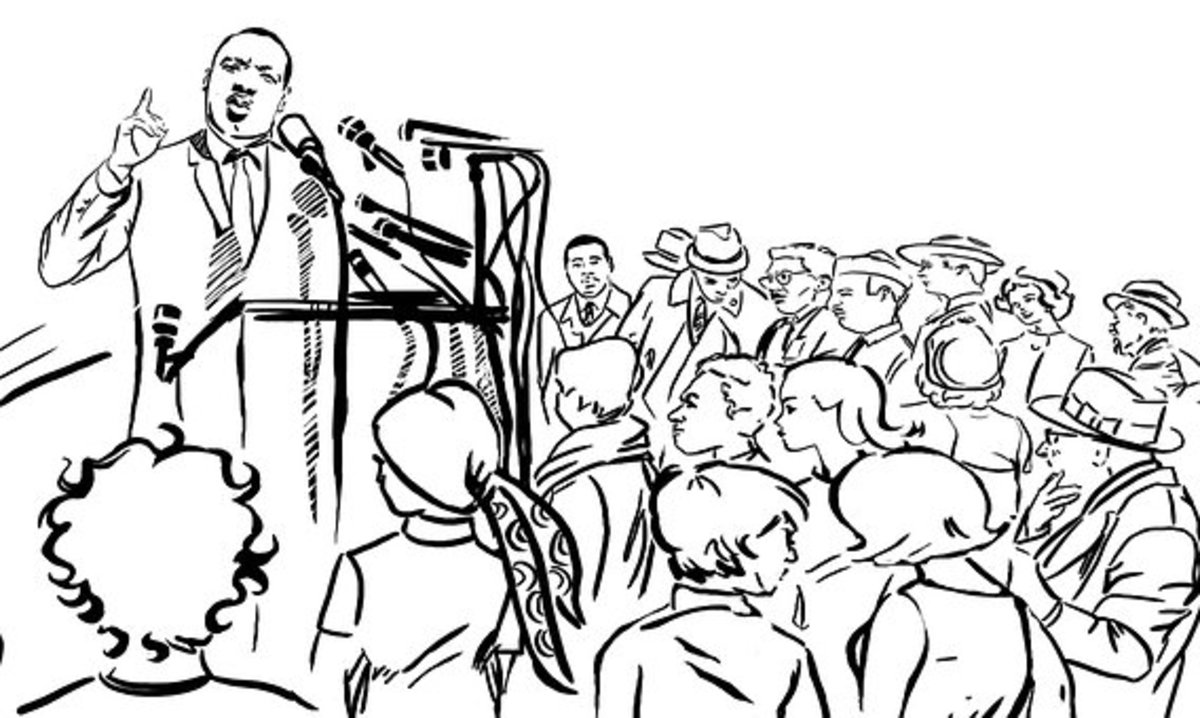ACE YOUR PRESENTATION by dispelling all fears
Basics - an addition
Are you a student wanting to blow your professor away and soar above 98% of the population? By turning fears or common misconceptions around, public speaking can be as easy as a math equation > calculators provided, keep your notes handy.
Have you ever walked out of giving a presentation and asked a friend for feedback only to hear, “What was your point?” You immediately think, “What was my point – ARE YOU KIDDING?” After 5 days of cramming every miserable piece of info you could find into this 10 minute, petrifying and mandatory presentation worth 40% of your grade…!
Indignation is quickly replaced by, “Oh my God! Did the professor not get it either?”
Relax – following these tried and true methods, your presentations could actually be fun - and everyone will get it. You might however, want to make your life easier by practicing a few times on that same friend before presenting next time.
BTW (no, you cannot submit contractions or anything even close to “btw”) - if you have a lot of fear about public speaking, you’re not alone. Statistical percentages say that twice as many people would rather die than speak in front of any audience. Once you learn how easily you can overcome your fears – you’ll be in the TOP 2% of society and can write your own ticket.
Sections: Outline Page 1
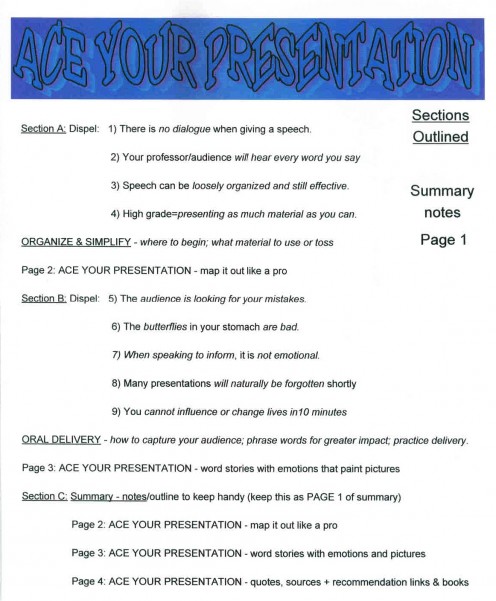
Dale Carnegie - additional public speaking books
Section A: Dispelling fears/misconceptions 1 - 4
Dispel #1) There is no dialogue when giving a speech:
An author for The New Yorker Times, David Sedaris (Louisville Courier-Journal, 6/5/05) said, "Writing gives you the illusion of control, and then you realize it's just an illusion, that people are going to bring their own stuff into it."
This is so true in public speaking or presenting material to any audience - it is the fundamental foundation to keep in mind. If you just “talk at” your audience, without allowing them time to digest what you say with pauses, or including them, as if in the “dialogue” of your speech – they will miss most of what you say.
Dispel #2) Your grading professor and audience will hear every word you say
Think back on some of the lectures you’ve heard. Did you catch every word? Did it all make sense? Or have you found yourself attempting to do the homework assignment wondering why the professor didn’t explain that part of the equation – especially if it was going to be assigned as homework. After you get through your frustration or wanting to cuss the professor's inefficiency, you start scrambling around to find someone else who may have either heard or understood what you missed.
Very few will catch every word. Follow Napoleon's advice on rhetoric below. Your Professor won't scramble when grading to see if just he/she missed it.
Dispel #3) Your speech/presentation can be loosely organized and still effective
We all take “mental vacations”. Quantum physics: our brains process 400 billion bits of information per second - 2,000 of them consciously. Whatever we present to people has to be more exciting just to compete. If presented without enthusiasm, or in a manner that's tough to follow, our minds will automatically drift off. Your professors are no exception.
Dispel #4) High grade = presenting as much material as you can.
It is a common mantra in public speaking to follow: 1) tell them what you’re going to say 2) tell them 3) tell them what you told them. This may bring up a fear of “redundancy” but the opposite is true. Speaking simply to entertain can be less organized but still ought to follow this same age-old mantra.
When presenting a new idea, needing your audience to think, make it as easy as possible for them to do so. By bringing them from where they are, to where you want them to be will help them accept your idea as well. In other words, "kiss it" - keep it simple.
Ever remember a time researching on the internet, clicking on other sites out of curiosity and getting so sidetracked you couldn't find your way back to the original one? That’s the picture I want you to keep in mind when writing for oral presentations.
We have to keep the main point prevalent in our listeners minds without letting them get sidetracked. Our whole purpose can get lost if we follow the temptation to share everything we researched. We may think this will impress the professor by showing added research time, but it will actually diminish your grade. Think of your speech as a finely tuned simple mathematical equation. There are certain components that make up the formula and when expressed accurately, there is an absolute and correct result.
Map it out like a Pro Page 2
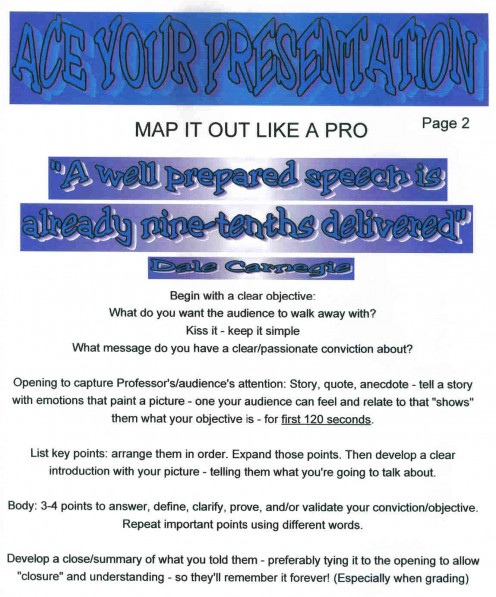
Basics - divide the anxiety myths (old but valid)
ORGANIZE & SIMPLIFY - where to begin; what material to use or toss
The place to start is to keep the end in mind. What do you want the audience to walk away with? What is your objective? What is the professor expecting you to know or prove? In other words, what are they asking you to research and come to the conclusion of?
Objective: ______________________________
Trying to come up with the opening first, without this clear objective could have you researching for weeks. Pin down your purpose to save time and to avoid writer’s block.
Gear all of your research to answering, defining, clarifying, proving or validating what you want them to walk away with. Even in your research or interviews, gear them all toward that end.
ANY material shared in your speech that doesn’t define, clarify, prove or validate your end, is a tangent from a different website. In the mathematical equation, it can only detract from your presentation or add an element sure to produce a wrong result – toss it! If it seems just too interesting a tid-bit not to include, then add it into your written version or give it a footnote - but don’t speak it.
The clear picture of your end – is your opening line. It’s the way you will capture your audience. Hard and fast rule: You have 120 seconds at the beginning of your speech to capture your listeners.
William Butler Yeats [1865-1939] said, “Think like a wise man but communicate in the language of the people.” If what you’re presenting seems too complicated for most to understand, all the more reason to come up with something they can relate to - and quickly. Jesus spoke in parables because he was presenting “concepts” – he needed to form them in a way that everyone could understand and visualize.
Communication is the key for success!
Section B: Dispelling fears/misconceptions 5 - 9
Dispel #5) The audience is looking for your mistakes
Picture yourself as an audience member. Are you hoping to sit through a boring, ill prepared monologue? NO, of course not – you want to learn or be entertained. If there is an audience member concerned about finding what you did wrong, they are weeds in a garden full of roses. The same is true of your professors. If you are self-conscious and thinking your professor would love to sit through dozens of lousy speeches, your perception needs to change. Your audience wants you to succeed.
The hard and fast rule of 120 seconds to capture their attention is because they will all be giving you the benefit of the doubt and hoping you know what you’re talking about - that will be decided in the first 2 minutes of your control at the lectern or on the podium.
When you come up with a clear picture they can relate to, clearly define what it is you’re going to be talking about, and exude the confidence of someone who has something they truly want to share – they’re yours. You can then take them anywhere you want them to go – which will of course be to the destination of accomplishing your objective.
Dispel #6) The butterflies in your stomach are bad.
Butterflies are great! Not only will they give you the added energy you need for enthusiasm, but as Francis Quarles states: "Let the fear of danger be a spur to prevent it; he that fears not, gives advantage to the danger".
That you are here fine-tuning and learning the how to's of presentation deliver is the first step to prevention. In a nutshell, once you know where you want to take them, it's easy to come up with a relevant opening. Memorize your opening so you can command the stage (even if you need notes for the body - memorizing the end too will leave that same confident, knowledgeable impression in their minds).
The best advice I learned from an entire course on becoming a TV/radio broadcaster was how to transform nervousness by lining up the butterflies. Appreciating that nervousness, or the 'butterflies' for their added energy and lining them up can change your life!
"If you do not conquer self, you will be conquered by self" - Napoleon Hill
Dispel #7) When speaking to inform, it is not emotional.
The way to avoid creating a bored audience, (especially the professor to ace it) is to engage their emotions… Until we connect with our audience emotionally, they’re only half tuned in to whatever we’re saying.
For years I thought presenting data would inevitably be boring. I also used to believe everything I knew about the subject had to be presented to impress - neither is true. Capturing them emotionally is the key.
Thinking a few visuals will alleviate boredom could also be suicidal - they will simply distract your listeners. Give them all the research on paper - let them be bored on their own time (again, just kidding - organizing your speech will help you organize your paper too). I'm not saying don't use visuals, simply don't use them as a crutch without applying the other techniques first.
Dispel #8) Many presentations will be forgotten shortly.
Adding quotes for credibility improves everything. Using them as an opening line is an easy attention getter, and memorable. Let me use a couple here from Dale Carnegie's books (1) "The Essence of Public Speaking":
“I MUST LIVE,” cried a young man to Voltaire; and the philosopher replied. “I do not perceive the necessity.”
That might be the attitude of the world toward what you have to say if you don't FEEL the necessity. Whatever you're speaking about needs to be, at least for the time being, the most important thing in the world. You need to have conviction, desire and 'impetus stirring in your talk”(2) "Public Speaking for Success"
(2-): "Restate Your Important Ideas in Different Words: Napoleon declared repetition to be the only serious principle of rhetoric. He knew that because an idea was clear to him was not always proof that others instantly grasped it. He knew that it takes time to comprehend new ideas, that the mind must be kept focused on them. In short, he knew they must be repeated. Not in exactly the same language. People will rebel at that, and rightly so. But if the repetition is couched in fresh phraseology, if it is varied, your hearers will never regard it as repetition at all”.
For addt'l information on this (and emotional word pictures) see: EFFECTIVE DELEGATION ultimate communication toolkit
Dispel #9) You cannot influence or change lives in 10 minutes.
The way to deliver a presentation that will last forever, and take the easiest route for both you and your audience to get involved is to tell stories with emotions that paint a picture. That will connect both sides of your listeners’ minds and their hearts.
Example: Instead of just saying "let's take a trip to the beach", be descriptive using all senses - Let's visit a warm beach. The sun is beaming down and soothing - caressing our bodies as it’s heat makes sweat bead on our skin. Our toes are squishing through the soft sand, and we can hear the waves rhythmically breaking on the shore in the distance. Ahhh – the crashing of the waves and the salty smell in the air, creating that contented peaceful feeling…
When we take the time to make our points in easily pictured parables, stories or words that convey feelings and our senses – again, you can take your audience anywhere you want and influence them for life (which also makes it easier for you to remember for presenting without notes).
Word stories painting emotional pictures Page 3
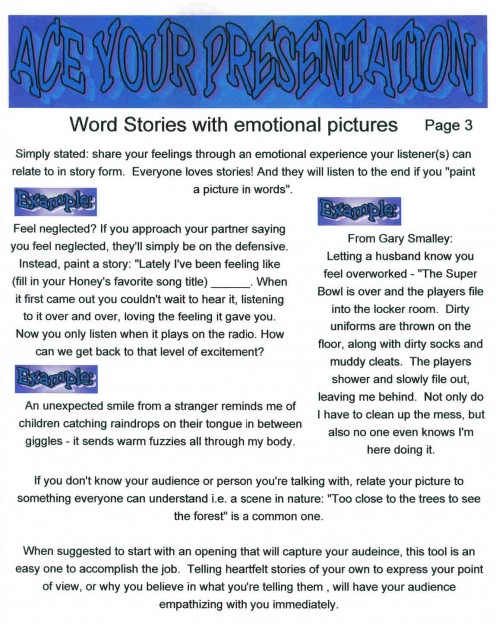
Section B: Oral delivery
The body of your presentation/speech is simply 3-4 points. Your audience won’t remember more than a few. Therefore, define 3 – 4 clear points to prove your perspective or conviction and paint them with emotional stories your audience will understand. It helps to know your audience. An International Speech Winner in Toastmasters says that the entire body consists of: 1) tell a story, make a point 2) tell a story, make a point and 3) tell a third story and make a third point.
If you are presenting something and don’t understand it well enough to see a picture or story to explain it, neither will your audience. Half of the secret to public speaking is having a zealous desire to communicate a real message from your head and heart to your audience’s heads and hearts. If there’s no personal connection, your audience won’t connect either. Discover your opinion to the material researched then personalize it, presenting with emotional conviction/enthusiasm.
Emphasizing how to practice for deliver is to keep the fact that 60% of our communication is subjective and shown through our facial expressions and body movement forefront in your mind. We cannot have contradictions between what we’re saying and what they can see and feel. If we simply say something was really funny with a frown – they’re not going to laugh. If we say, “What he did should have had him thrown in jail for cruelty to humanity” with a smile on our face, they won’t be moved. Act out those painted pictures through body movement and gestures – large enough to involve the whole audience.
Express yourself with conviction & enthusiasm!

Inexpensive - guaranteed to be one near you
- Toastmasters International - Home
Become the Leader and Speaker you want to be
In summary (not a statement you want to use in oral presentations):
To alleviate fear: Decide what it is you feel a true relevant conviction about.
Clarify what you want them to walk away with. Keep the end in mind – your objective.
Come up with an emotional picture that explains your objective and how you feel about it with the impetus that your talk is earth shattering and important.
Then tell them what you’re going to talk about,
Keep it to 3 or 4 clear points through relevant and understandable stories
Add to your confidence by memorizing your opening and ending.
Practice eliminating any subjective contradictions between what you’re saying, the stories you’re telling and your facial and body movements and gestures.
Then conclude by clearly stating what you presented.
In the words of Lee Iaccoca, “You’ve got to say, ‘I think if I keep working at this and want it badly enough, I can have it.’”
Apply these tools in your presentations and all communications to create whatever you want in life.
If you'd like the 4 summary pages in pdf - feel free to ask. I'd be happy to email them to you. And/or if you'd like a sample speech showing all the techniques incorporated, the same applies. :)
Quotes, sources + recommendation links & books Page 4
